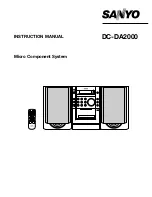
API “The BOX”
Operator’s Manual
66
soloed audio is heard in the loudspeakers in stereo. The program bus outputs are
unaffected when an AFL solo is engaged (non-destructive).
The overall solo level is controlled with the solo TRIM pot.
SIP (Solo-In-Place)
When SIP is the current solo mode and a SOLO switch is engaged on an input channel
or summing channel, all non-soloed channels are muted and the soloed channels are
heard in the loudspeakers via the program bus. Since all non-soloed channels are
muted when a SOLO is engaged, this mode is considered to be “destructive.” Neither
solo bus is used and the current control room monitor source is not replaced in SIP
mode.
PFL and AFL solo modes are not available when SIP is engaged.
NOTE: When solo-in-place (SIP) is the current solo mode, engaging an aux or cue
master AFL SOLO switch will activate the current PFL or AFL solo function.
The solo function is determined by the position of the AFL switch in the solo
master section. Engaging an aux or cue master AFL SOLO while in SIP mode
will not active the SIP solo mode.
10.2 Solo Master Controls
Solo-In-Place (SIP) is a stereo, destructive solo mode. SIP is active
when the SIP switch is engaged. SIP solo can be activated from input
channels and summing inputs.
AFL (after-fader-listen): Enables the after-fader-listen solo
mode
•
Illuminates when engaged
TRIM: Stereo solo bus level trim-pot
•
-10dB to +10dB
•
Center detent is 0dB (unity gain)
SIP (solo-in-place): Enables the solo-in-place solo mode
•
Illuminates when engaged
SOLO CLEAR: Disengages all currently engaged SOLO switches
•
Momentary switch
•
Illuminates when any channel or master SOLO switch is
engaged
Engaging the SAFE switch on a input channel or summing input will
prevent it from being muted when a SIP SOLO is engaged on another
channel. This is useful on input channels when recording, when
channel(s) are being used as effects return, and other applications.
















































